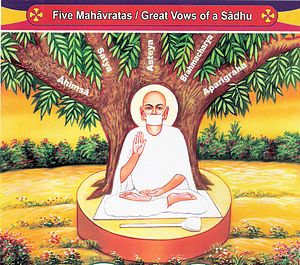The Jain laity makes up the vast majority of the faith’s numbers and is responsible for supporting the Sadhus/Sadhvis. Most of the world’s Jains live in various parts of India depending on their sect. What is important to note about the various sects within the Jain philosophy is that while one group may reject the scriptures of another (the Digambara reject the Svetambara canon), this does not result in sectarian conflict. Each group is not viewed as a rival, but simply as another point of view from which to see the path. The Triple Gems of right faith, right knowledge, and right conduct apply to all Jains regardless of this minute differences and all Jains accept an identical philosophy called the Nine Tattvas (principles):
- Jiva–all living beings. Every living being has a soul or consciousness (atma or chetan). This includes everything from a single cell organism to a whale. The soul is a formless, eternal, indestructible substance (like energy) which occupies several life forms until it reaches moksha (liberation).
- Ajiva–all non-living material. Ajiva falls into five categories: the medium of motion, the medium of rest, space, time, and matter. Karma, in the Jain philosophy, is a category of matter which bonds to the soul.
- Asvara–the cause of influx of karma. Karma interacts with and bonds to the soul via attachment to any emotion, reaction, or action–positive or negative.
- Bandh–the actual bonding of karmic particles to the soul. This occurs whenever we react to a situation with attachment or aversion.
- Punya–positive karmic particles resulting from virtuous acts such as charity. Once punya matures, we experience worldly comfort and happiness.
- Pap–the opposite of punya. These negative karmic particles mature and attach themselves to the soul due to acts such as malice, disrespect, and violence.
- Samvara–the act of stopping the karmic influx. This is achieved by observing samiti (the 5 carefulnesses), gupti (the three controls), monkhood, observing the 12 meditations, and suffering (handling hardship with grace and indifference).
- Nirjara–removal of accumulated karma. Karmic particles mature and leave the soul in due time. Like a tomato on the vine, we can either wait for karma to naturally ripen (this could take many lifetimes) or we can actively speed the process. Such actions to speed the process include penance, asking for forgiveness, meditation, etc.
- Moksha–when all karmic particles are removed from the soul, we are completely free. This is the goal.
This is the foundation of Jain philosophy. Laity or monk/nun, all Jains believe in this path.
Because the Jain laity does not go through the monastic measures of karmic removal, they go through their daily lives with great care in doing as little damage as possible. Most Jains, for example, take up jobs in business so as to cause little direct harm to jiva (living things). Jains also support the Sadhu/Sadhvis community as an act of respect and veneration for those taking the hard yet necessary steps toward moksha. A vegetarian diet is also crucial for all Jains regardless of sect. This practice stems from the most important practice of all: ahimsa (non-injury). Jains are careful in even their vegetable selections. Root plants such as potatoes, for example, are avoided because their consumption kills the entire plant. Many animal shelters in India are run by Jains, both the laity and the monks.
Meditation on the 12 contemplations (Bhavanas), is also part of Jain daily life. Each topic helps focus the mind and therefore directs the Triple Gems of right belief, right knowledge, and right conduct. I will go over these meditation topics later.
In this way, the Jain way of life seems to be filled with anxiety and avoidance. The reality is that rather than anxiety, Jains are actively conscious of their surroundings and the condition of all life. Even an insulting thought is avoided. For this reason, Jains practice a daily act of penance and renewal called “Pratikrama.” The word itself means “returning from violations.” It is through this process that Jains review their daily actions, repent for any harm they may have caused, and study Jain philosophy for ways to improve. This practice is typically followed twice a day in the morning and evening. The steps include:
- Samayik–reaching a state of equanimity. At this time we commit to reciting the Navkar Mantra, remember the virtues of the Tirthankaras, and meditate on the 12 reflections. This is how we set the mood and mindset.
- Chauvissantho–a recitation which praises the 24 Tithankaras and reminds us of their virtues.
- Vandana–if in the presence of Sadhus/Sadhvis, this act honors them and their path toward moksha.
- Pratikraman–realizing our mistakes, atoning for them, and avoiding the same mistakes in the future.
- Kayotsagga–still meditation on the soul. The soul is the perfected state outside the body. Here we sit or stand in silent, still meditation avoiding all attachment or aversion to discomfort or outside stimuli.
- Pratyakhyan–renunciation of certain actions, thoughts, feelings which attract karmic bondage.
So that is a brief look into the daily life and philosophy of typical Jain. What are some of the practices or philosophies that you could adopt for your life?

